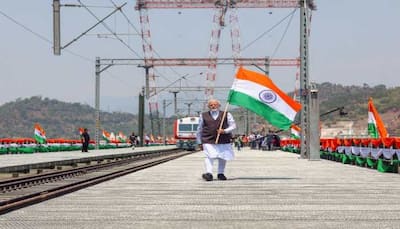New Delhi: In a moment that may go down as a masterstroke in India’s strategic playbook, Prime Minister Narendra Modi on June 6 unveiled the world’s tallest railway bridge – the Chenab Bridge – along with a series of infrastructure marvels in Jammu & Kashmir. While hailed as engineering triumphs, these structures hide within them a fierce geopolitical message – India is silently fortifying its Himalayan frontier, and Pakistan and China are not happy.
At 359 metres tall, taller than the Eiffel Tower, the steel-arched Chenab Bridge is part of the 272 km Udhampur-Srinagar-Baramulla railway link (USBRL) and connects the Kashmir Valley to the Indian rail grid for the first time. But beyond the awe and applause, it is the military and counter-terror implications that have sent shockwaves across the border.
The bridge sits near the treacherous Pir Panjal Range, a mountainous region that has for decades acted as a gateway for Pakistani infiltrators, including ISI-backed terrorists from the Lashkar-e-Toiba and the Jaish-e-Mohammed.
From Poonch and Rajouri to the lush forests near Pahalgam, this route has seen some of the most notorious attacks in India’s history.
Now, with the Chenab and Anji bridges completed and the valley more accessible to India’s armed forces year-round, this infiltration corridor is on the verge of collapse.
“This is not just a bridge. It’s a steel-fisted message to our enemies,” said a top defence expert, requesting anonymity.
The bridge does not only deter Pakistan. It tightens India’s grip over the Jammu-Kashmir-Ladakh axis, critical to countering Chinese aggression along the Line of Actual Control (LAC).
Troops, weapons and surveillance units can now move seamlessly – no more seasonal delays or logistical gaps.
This “Chenab Chakravyuh” – as called by military strategists – is a geo-strategic snare apart from being about connectivity. With 24/7 surveillance cameras, anti-corrosion technologies and blast-resistant materials, the bridge is built to withstand earthquakes of 8.0 magnitude and even terrorist bombing attempts.
“They tried to divide us by using religion and terror. We are responding with steel, resolve and railways,” said a senior Indian Army official deployed in the region.
Built with inputs from Indian Institute of Technology and the Defence Research, the Development Organisation (DRDO) and global experts, the Chenab Bridge uses high-tensile steel and advanced cable-crane systems.
It is designed to last 120 years even under wind speeds of 260 kmph.
And with two Vande Bharat trains flagged off from Katra to Srinagar, civilian integration of the region is now irreversible.
What rattles Rawalpindi most is that this is blocking terrorists and rendering their long-game obsolete. For years, Pakistan has exploited difficult terrain and porous routes to fuel unrest in the valley. That door just slammed shut.
Even Pakistan Field Marshal Asim Munir must now contend with the fact that Pir Panjal no longer favours infiltration, it favours India.
Stay informed on all the , real-time updates, and follow all the important headlines in and on Zee News.








